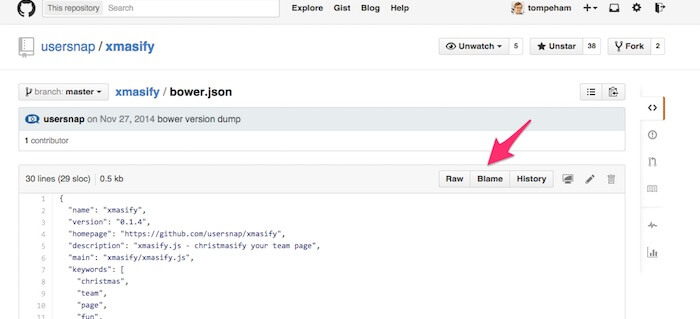

This may be useful to rebuildĮverything from scratch, but keep manually created files.ĭon’t actually remove anything, just show what would be done. With git reset) to create a pristine working directory to test a clean This can be used (possibly in conjunction This allows removing all untracked files, gitignore (perĭirectory) and $GIT_DIR/info/exclude, but do still use the ignore The report does not tell you anything about lines which have been deleted or. The Repositoriestool window will open containing the snapshot of your project at the selected revision. Select a commit and choose Show Repository at Revisionfrom the context menu. git log -S'hello world' - src/ This shows commits in which 'hello world' is added or removed. Open the Gittool window Alt+9and switch to the Logtab.
#Git blame deleted line code#
That means if u remove a code piece, then the reference to that code will decrease by 1.
Lines that were changed or added by an ignored commit will be blamed. Try git log -S'' - , it shows commits in which occurrence of specified string changes. #Git blame deleted line manual#
If the Git configuration variable clean.requireForce is not set toįalse, git clean will refuse to run unless given -f, -n or -i.ĭon’t use the standard ignore rules read from. GIT-BLAME(1) Git Manual GIT-BLAME(1) NAME git-blame - Show what revision. Ignore changes made by the revision when assigning blame, as if the change never happened. If clean.requireForce is set to "true" (the default) in your configuration, one needs to specify -f otherwise nothing will actually happen.Īgain see the git-clean docs for more information. Tutorials Git blame git status git tag git blame The git blame command is a versatile troubleshooting utility that has extensive usage options. git blame -reverse START is taken as git blame -reverse START.HEAD for convenience. This requires a range of revision like START.END where the path to blame exists in START. Instead of showing the revision in which a line appeared, this shows the last revision in which a line has existed. Note the case difference on the X for the two latter commands. Walk history forward instead of backward.
To remove ignored and non-ignored files, run git clean -f -x or git clean -fx. To remove ignored files, run git clean -f -X or git clean -fX How do I git blame a deleted line Question: git blame is great for modified and added lines, but how can I find when a line that existed in a specific previous commit was eventually deleted. To remove directories, run git clean -f -d or git clean -fd. Step 1 is to show what will be deleted by using the -n option: # Print out the list of files and directories which will be removed (dry run)Ĭlean Step - beware: this will delete files: # Delete the files from the repository Since in commit lmn 2 lines were deleted (line 1 and 2), PyDriller can retrieve the commits in which those lines were last modified (in our example, commit abc. arguments are given, only those paths are affected. This can, for example, be useful to remove all build products. 
Normally, only files unknown to Git are removed, but if the -x option is specified, ignored files are also removed.

Git-clean - Remove untracked files from the working tree Synopsis git clean …Ĭleans the working tree by recursively removing files that are not under version control, starting from the current directory.


 0 kommentar(er)
0 kommentar(er)
